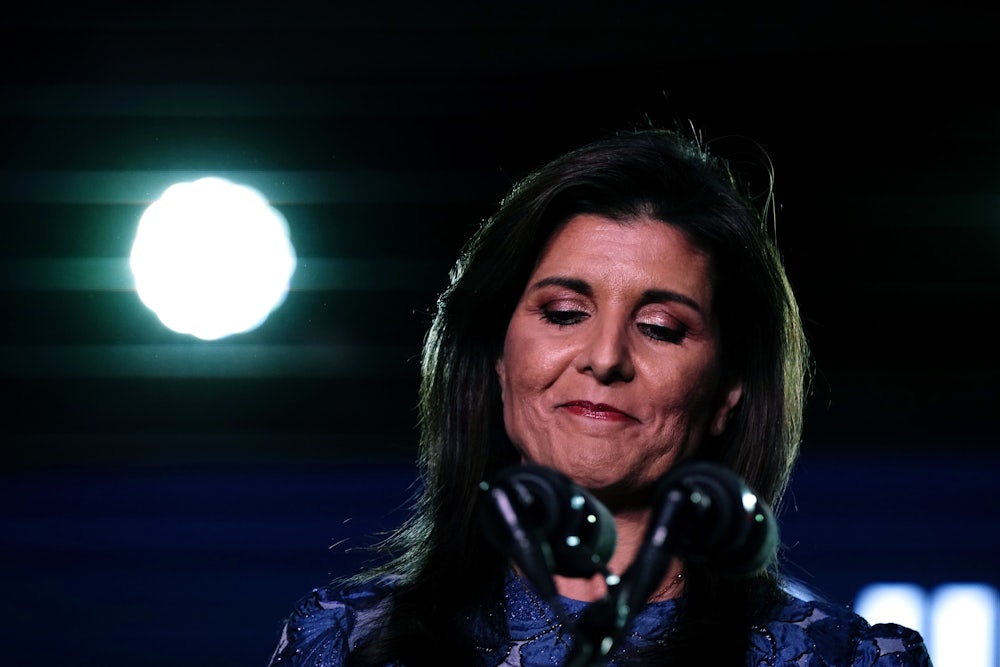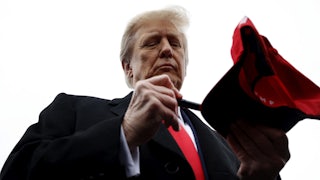Nikki Haley will always have Dixville Notch, whose six midnight votes in Tuesday’s New Hampshire primary she carried unanimously. The former South Carolina governor can also revel in having swept Johnson County, Iowa, the home of the University of Iowa, by a single vote over Donald Trump in last week’s caucuses.
But, after what appears to be a double-digit defeat Tuesday night in New Hampshire, Haley is on the losing side of the most lopsided contested race for a presidential nomination in either party since the rise of presidential primaries in 1972. The former U.N. ambassador put on a brave spin in her concession speech in Concord: “This race is far from over. There are dozens of states left to go. And the next one is my sweet state of South Carolina.”
On paper, everything went right for Haley in New Hampshire. The rapid withdrawals of Ron DeSantis, Chris Christie, and Vivek Ramaswamy gave her the head-to-head race with Trump that she had craved. Independent voters, who could vote in the primary, went for Haley by a 61–37 margin according to the exit polls. Unlike Iowa, where Trump reaped the benefits of his Faustian bargain with evangelical voters, only 19 percent of New Hampshire GOP voters described themselves as “born again.”
And still it wasn’t enough. To Haley’s credit, she appeared to outpace most of the pre-primary polls, which showed her losing to Trump by as many as 20 percentage points. But it is hard to detect a path to victory when you finish second in a two-candidate race. If Haley continues, she may beat the record set by Mo Udall in the 1976 Democratic race, who finished second to Jimmy Carter in six separate primaries.
Other losing candidates have vowed to go on as Ron DeSantis did after finishing a weak second to Trump in Iowa. But the challenge for Haley in the weeks ahead is threefold: Will her super PAC donors abandon ship in the face of Trump’s almost-certain nomination? Does Haley have the gumption to endure daily questions from the media about when she will drop out? And can she endure the next giant wave of Republican quislings, who should know better, rushing to endorse Trump?
Haley may not have anything as large as a glimmer of a chance, but she does have a micron of hope.
Because of a weird wrinkle in the GOP calendar, the next major contest is indeed in South Carolina on February 24, followed by the Michigan primary on February 27. That scheduling gap will give Republicans a month to ponder whether they really want to renominate a defrocked former president whose support almost entirely depends on white voters without a college degree. In a clever line Tuesday night, Haley declared, “The first party to retire its 80-year-old candidate is going to win this election. I say it should be the Republicans.” There is also the chance that Trump may demonstrate further signs of cognitive impairment, fresh on the heels of his bizarro confusion of Nancy Pelosi and Haley when bloviating about responsibility for the January 6 insurrection.
But what is almost certain is that the music died on Tuesday night. The Republican Party of John McCain (winner in New Hampshire in 2000 and 2008) and Mitt Romney (the victor in 2012) no longer exists. The GOP should rename itself the “Trumpicans” and exchange the elephant as a symbol for a vulture feeding on the carrion of democracy.
It is fashionable on the left to refer to Trump supporters as a “cult.” But it can also be argued that the Trump constituency are rubes and suckers who cannot accept that they have pledged their life savings to a charlatan and a snake-oil salesman. In their delusions, they fail to realize that Trump has led them to defeat and disappointment in the last three elections—and he threatens to do it again in 2024. Perhaps the most telling set of numbers in the exit polls revolved around the 2020 election: 77 percent of Haley supporters and just 21 percent of Trump backers believe that Joe Biden was legitimately elected.
In 2016, Trump benefited from naïve “he will grow in office” fantasies about his behavior when entrusted with the nuclear codes. In 2020, for all of his erratic behavior, Trump probably gained from the power of incumbency. But this time around, as Trump cannot resist reminding us, is a “retribution” election, in which he intends, if reelected, to use the power of the presidency for cold-blooded revenge.
With the threat from Trump so stark, this is the moment to form the broadest possible coalition around Joe Biden. The only litmus should be a passion for democracy and the rule of law.
I will happily concede that Biden will never be an inspiring candidate—and his second-term agenda is at best vague. But fate has also decreed that our first octogenarian president is the last bulwark against Trumpian autocracy. That is why it is fine to argue about the future direction of the Democratic Party. But it is also why those debates over domestic and foreign policy should be put on hold until January 20, 2025. What matters more than anything is that the Constitution will still be there on January 20, 2029, with Biden in the White House.
Trump, with his domination of the sad remnants of the Republican Party, becomes only the fifth man since the Civil War to be nominated for president three times. (The others range from Franklin Roosevelt and Grover Cleveland to William Jennings Bryan and the inescapable Richard Nixon.)
But, in a sense, it may be better this way. An abject, landslide defeat is the only way to remove the contagion that Trump represents from the American political system. And while the polls are currently daunting for Biden (and very premature), there is a possibility that a Trump conviction in the federal government’s January 6 case and his continued erratic behavior on the stump could make all the difference.
The message from Iowa and New Hampshire is that Trump is not winning new converts. His supporters are passionate, deluded, and far less than a majority of the entire electorate. Only a political party with the death wish of lemmings would possibly nominate him for president again.




